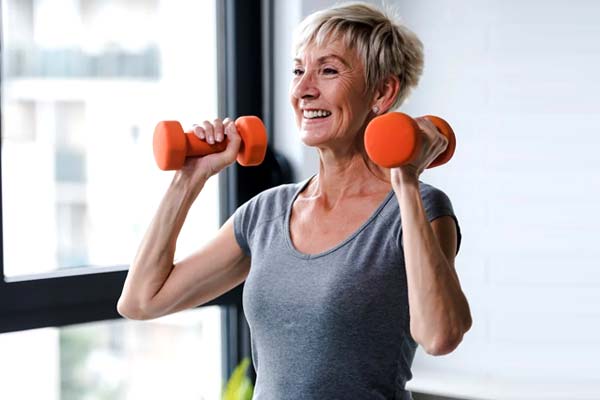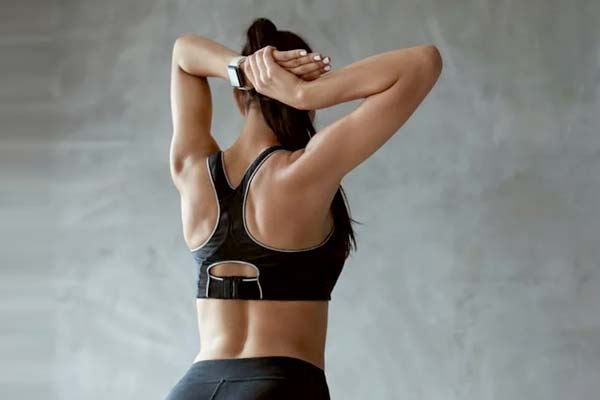تمارين منزلية لمرضى السكري من النوع الثاني: نشاط وحيوية في الخمسينات
مع العمر ، يزداد احتمال الإصابة بمرض السكري من النوع الثاني ، ويمكن أن يكون من الصعب العثور على طرق للبقاء نشطًا وصحيًا. ومع ذلك ، يمكن للأشخاص الذين يعانون من السكري من النوع الثاني الاستفادة من ممارسة التمارين الرياضية اليومية لتحسين مستويات السكر في الدم والصحة العامة. يمكن لليوغا والبيلاتيس وغيرها من التمارين الرياضية البسيطة التي يمكن القيام بها في المنزل أن تكون خيارات رائعة للأشخاص الذين يعانون من السكري في سن الخمسينات.
يمكن للأشخاص الذين يعانون من السكري من النوع الثاني الاستفادة من ممارسة التمارين الرياضية اليومية لتحسين مستويات السكر في الدم والصحة العامة. يمكن لليوغا والبيلاتيس وغيرها من التمارين الرياضية البسيطة التي يمكن القيام بها في المنزل أن تكون خيارات رائعة للأشخاص الذين يعانون من السكري في سن الخمسينات. يساعد التمرين على تحسين حساسية الخلايا للأنسولين ويساعد في السيطرة على مستويات السكر في الدم. يمكن للأشخاص الذين يعانون من السكري الاستفادة من هذه التمارين الرياضية البسيطة لتحسين صحتهم العامة والبقاء نشطين وصحيين.
يمكن للأشخاص الذين يعانون من السكري الاستفادة من التمارين الرياضية البسيطة التي يمكن القيام بها في المنزل للمساعدة في تحسين حالتهم الصحية. يمكن أن يكون لليوغا والبيلاتيس وغيرها من التمارين الرياضية البسيطة تأثير إيجابي على مستويات السكر في الدم والوزن والضغط الشرياني. يمكن للأشخاص الذين يعانون من السكري من النوع الثاني الاستفادة من هذه التمارين الرياضية البسيطة لتحسين صحتهم العامة والبقاء نشطين وصحيين.
المشي
المشي هو واحد من أسهل التمارين الهوائية التي يمكن القيام بها دون الحاجة إلى أي معدات خاصة. يمكن للأشخاص الذين يعانون من مرض السكري من النوع 2 الاستفادة من المشي لتحسين مستويات A1C ومستويات السكر في الدم.
ينصح بالمشي لمدة 30 دقيقة يوميًا، ويمكن تقسيمها إلى فترات قصيرة خلال اليوم، مثل 10 دقائق في الصباح و10 دقائق بعد الغداء و10 دقائق في المساء.
يمكن أيضًا زيادة عدد الخطوات التي يتم المشي عليها بشكل تدريجي. يمكن للأشخاص الذين يعانون من مرض السكري من النوع 2 الاستفادة من جهاز تعقب الخطوات لتحديد عدد الخطوات التي يتم المشي عليها يوميًا.
عند المشي، يجب على الأشخاص الذين يعانون من مرض السكري من النوع 2 ارتداء حذاء مريح والتأكد من تناول كمية كافية من الماء. كما يجب عليهم اصطحاب حبة فاكهة أو وجبة خفيفة لتجنب الانخفاض الحاد في مستويات السكر في الدم.
بالإضافة إلى تحسين مستويات A1C ومستويات السكر في الدم، يمكن للمشي أيضًا تحسين الصحة العامة واللياقة البدنية وتقليل خطر الإصابة بأمراض القلب والأوعية الدموية.
البيلاتس
تعتبر البيلاتس من التمارين الرائعة لمرضى السكري من النوع الثاني الذين يتجاوزون سن الخمسين، وذلك لأنها تساعد على تقوية العضلات وتحسين التوازن والتنفس. وتعتمد هذه التمارين على استخدام الأجهزة الرياضية الصغيرة مثل الكرات والأشرطة المطاطية والحلقات.
تشمل تمارين البيلاتس تمارين التوازن وتمارين المقاومة، والتي تساعد على تحسين اللياقة البدنية والتحكم في مستويات السكر في الدم. كما أن تمارين البيلاتس تساعد على تحسين المرونة وتقوية العضلات الأساسية، مما يساعد على تحسين الوضعية الجسدية وتخفيف آلام الظهر.
يمكن لمريض السكري القيام بتمارين البيلاتس في المنزل باستخدام أشرطة مطاطية وكرات صغيرة، ويمكن الحصول على تمارين البيلاتس من خلال الإنترنت أو من الكتب والأشرطة التعليمية.
لا يجب على مرضى السكري القيام بتمارين البيلاتس دون استشارة الطبيب المعالج، ويجب مراقبة مستويات السكر في الدم قبل وبعد التمرين لتجنب حدوث أي مضاعفات. كما ينصح بتناول وجبة خفيفة قبل التمرين وشرب الماء بانتظام لتجنب الجفاف.
الرقص
تعدّ الرقصة واحدة من الأنشطة الرياضية الممتعة التي يمكن للأشخاص الذين يعانون من مرض السكري من النوع الثاني الاستمتاع بها. يمكن للرقص أن يساعد في تحسين صحة القلب والأوعية الدموية وتحسين اللياقة البدنية. كما يمكن أن يساعد في تخفيف الإجهاد والتوتر وتعزيز الصحة العقلية.
تحتاج الرقصة إلى تمارين القلب والتمارين الأيروبيكية والتي يمكن أن تساعد على تحسين الصحة العامة للجسم. يمكن للرقصة أن تختلف من ناحية الأسلوب والنوع، فمن المهم اختيار النوع الذي يناسب الشخص والذي يمكنه ممارسته بشكل منتظم.
يمكن للرقصة أن تكون مرحة وممتعة، ويمكن للأشخاص الذين يعانون من مرض السكري من النوع الثاني الاستمتاع بها مع العائلة والأصدقاء. يمكن ممارسة الرقصة في المنزل باستخدام الفيديوهات التعليمية عبر الإنترنت أو الحضور إلى صفوف الرقص في النادي الرياضي.
يجب على الأشخاص الذين يعانون من مرض السكري من النوع الثاني مراقبة مستوى السكر في الدم وتناول الوجبات بشكل منتظم قبل وبعد التمرين. كما يجب ارتداء الأحذية الرياضية المناسبة والتي توفر الدعم اللازم للقدمين.
ركوب الدراجات
تعتبر ركوب الدراجات من التمارين الرائعة لمرضى السكري من النوع الثاني في الخمسينيات من العمر. فهي تساعد على تحسين قدرة الجسم على استخدام الأنسولين وتخفيض مستويات السكر في الدم. كما أنها تعمل على تحسين الصحة القلبية والوظائف الرئوية.
يمكن لمريض السكري ركوب الدراجة في الهواء الطلق أو داخل المنزل باستخدام الدراجة الثابتة. يمكن تحديد الوقت والمسافة والمقاومة المناسبة لمستوى اللياقة البدنية الحالي.
ومن الجيد أن يبدأ المريض بالتدريج وزيادة الوقت والمسافة تدريجياً. يمكن أيضاً تغيير السرعة والمقاومة لتحسين التحدي وتحفيز الجسم.
يمكن أيضاً ممارسة تمارين الايروبيك الأخرى مثل المشي والرقص والسباحة وتمارين المقاومة مثل رفع الأثقال لتحقيق أفضل النتائج في تحسين الصحة العامة وإدارة السكري.
ومن المهم التأكد من استشارة الطبيب قبل بدء أي نشاط رياضي جديد، وتوخي الحذر في حالة وجود أي أعراض غير طبيعية أثناء ممارسة التمارين الرياضية.
التدريب المتواتر عالي الكثافة
يعد التدريب المتواتر عالي الكثافة (HIIT) خيارًا رائعًا للأشخاص الذين يعانون من السكري من النوع 2 الذين يرغبون في الحفاظ على لياقتهم البدنية. يتضمن HIIT تمارين قصيرة وشديدة الحدة متبوعة بفترات قصيرة من الراحة. يمكن أن يحسن HIIT حساسية الأنسولين ويساعد في خفض مستويات السكر في الدم.
يمكن للأشخاص الذين يعانون من السكري من النوع 2 الذين يمارسون HIIT أن يتحسنوا في اللياقة البدنية ويخفضوا مستويات الدهون في الدم والكوليسترول السيئ والتهابات الجسم. كما يمكن أن يحسن HIIT صحة القلب والأوعية الدموية ويقلل من خطر الإصابة بأمراض القلب.
ومع ذلك، يجب أن يتم تنفيذ HIIT بحذر وتحت إشراف مدرب مؤهل. يجب على الأشخاص الذين يعانون من السكري أن يتحدثوا مع أطبائهم قبل البدء في أي برنامج تمرين. كما يجب عليهم التأكد من قياس مستوى السكر في الدم قبل وبعد التمرين.
يمكن للأشخاص الذين يرغبون في ممارسة التمارين القلبية الأخرى أن يختاروا تمارين مثل المشي والركض وركوب الدراجات والسباحة. يمكن أيضًا للأشخاص الذين يحبون اليوغا والبيلاتس أن يستمتعوا بفوائد اللياقة البدنية والصحية من هذه التمارين.
بالإضافة إلى ذلك، يجب على الأشخاص الذين يعانون من السكري أن يتبعوا نظامًا غذائيًا صحيًا ويتحدثوا مع أطبائهم حول أي تغييرات يرغبون في إدخالها في حياتهم اليومية.
التمدد
تعتبر تمارين التمدد جزءًا مهمًا من الروتين الرياضي لمريض السكري من النوع الثاني في الخمسينيات. تساعد هذه التمارين على تحسين مرونة العضلات والمفاصل، وتخفيف التوتر والتواءات الجسم. يمكن للمريض القيام بتمارين التمدد بشكل يومي في المنزل، ولكن يجب عليه استشارة الطبيب قبل البدء في أي نوع من التمارين.
تتضمن تمارين التمدد تمارين اليوجا والبيلاتيس وغيرها من التمارين التي تركز على تمديد العضلات وتحسين المرونة. يمكن للمريض القيام بتمارين التمدد في أي وقت من اليوم، ولكن يجب عليه الانتباه إلى الأوقات التي يشعر فيها بأعراض السكري مثل انخفاض السكر في الدم.
تمارين التوازن هي أيضًا جزء مهم من الروتين الرياضي لمريض السكري من النوع الثاني في الخمسينيات. تساعد هذه التمارين على تحسين التوازن والتنسيق وتقليل خطر السقوط. يمكن للمريض القيام بتمارين التوازن بمساعدة العصي أو الكرات الكبيرة.
تمارين المرونة هي أيضًا جزء مهم من الروتين الرياضي لمريض السكري من النوع الثاني في الخمسينيات. تساعد هذه التمارين على تحسين مرونة العضلات والمفاصل وتقليل الإصابة بالإجهاد والتواءات. يمكن للمريض القيام بتمارين المرونة بمساعدة الأشرطة المطاطية أو الكرات الصغيرة.
بشكل عام، يجب على المريض السكري من النوع الثاني في الخمسينيات الحرص على القيام بتمارين رياضية منتظمة للحفاظ على صحته العامة وتحسين مستويات السكر في الدم. ومن المهم الحرص على الاستشارة الطبية قبل البدء في أي نوع من التمارين الرياضية.
تمارين المقاومة
تعتبر تمارين المقاومة من الأنشطة البدنية المهمة التي يمكن للأشخاص الذين يعانون من مرض السكري من النوع الثاني ممارستها في منزلهم. تعمل هذه التمارين على تحسين صحة العضلات وزيادة كتلة العضلات وتحسين مستويات السكر في الدم. يمكن للأشخاص الذين يعانون من مرض السكري من النوع الثاني الاستفادة من تمارين المقاومة لتحسين صحتهم.
يمكن القيام بتمارين المقاومة باستخدام الأوزان الحرة مثل الأثقال الخفيفة أو الأوزان الثقيلة، وكذلك باستخدام الأدوات المختلفة مثل الحبال والمقابض. يمكن للأشخاص الذين يريدون ممارسة تمارين المقاومة في المنزل البحث عن مقاطع الفيديو على الإنترنت التي توضح كيفية القيام بتمارين المقاومة بشكل صحيح.
تشمل تمارين المقاومة تمارين العضلات الرئيسية مثل تمارين الصدر والظهر والأرجل والبطن والذراعين. يمكن القيام بتمارين المقاومة بشكل منفصل عن بعضها البعض أو بشكل متكامل لتحقيق أقصى فائدة.
يمكن للأشخاص الذين يعانون من السكري من النوع الثاني أن يبدؤوا بتمارين المقاومة بشكل بسيط وتدريجي، وزيادة الوزن وعدد المجموعات تدريجياً. يجب على الأشخاص الذين يعانون من مرض السكري من النوع الثاني الحرص على مراقبة مستويات السكر في الدم قبل وبعد ممارسة التمارين المقاومة.
يمكن للأشخاص الذين يعانون من مرض السكري من النوع الثاني الاستفادة من تمارين المقاومة لتحسين صحتهم والحفاظ على مستويات السكر في الدم في المدى الطويل.
دمج التمارين
يعد دمج التمارين من أفضل الطرق لتحسين صحة الأشخاص الذين يعانون من السكري من النوع الثاني في الخمسينيات من العمر. يمكن للتمارين المتنوعة أن تساعد في تحسين مستويات السكر في الدم وخفض مستويات الألبومين في الدم (الذي يدل على الأضرار التي تسببها السكري في الكلى). يمكن دمج تمارين الأيروبيك وتمارين المقاومة لتحقيق أفضل النتائج.
تتضمن تمارين الأيروبيك النشاطات الرياضية التي تزيد من ضربات القلب وتحسن التنفس، مثل المشي والركض وركوب الدراجات والرقص. يمكن لتمارين الأيروبيك أن تساعد في تحسين صحة القلب والأوعية الدموية وتحسين مستويات السكر في الدم.
تتضمن تمارين المقاومة استخدام الأوزان أو الأجهزة المصممة لتحمل الضغط لتقوية العضلات. يمكن لتمارين المقاومة أن تساعد في تحسين كتلة العضلات والحفاظ على كتلة العظام وتحسين مستويات السكر في الدم.
يمكن دمج تمارين الأيروبيك والمقاومة في نفس الجلسة التدريبية. على سبيل المثال، يمكن للشخص القيام بتمارين الأيروبيك مثل المشي على جهاز المشي أو ركوب الدراجة الثابتة لمدة 20 دقيقة، ثم الانتقال إلى تمارين المقاومة مثل رفع الأثقال لمدة 20 دقيقة.
يجب على الأشخاص الذين يعانون من السكري من النوع الثاني في الخمسينيات من العمر الحرص على ممارسة التمارين بانتظام وفي نفس الوقت الحرص على مراقبة مستويات السكر في الدم والتحدث مع الطبيب قبل البدء في أي برنامج تدريبي جديد.
التمارين وسكر الدم
تعد التمارين الرياضية من العوامل الأساسية التي تساعد في السيطرة على مستوى سكر الدم لدى مرضى السكري من النوع الثاني. وفقًا للجمعية الأمريكية لمرضى السكري، يوصى بممارسة التمارين الرياضية المعتدلة إلى الشديدة لمدة 150 دقيقة في الأسبوع، بالإضافة إلى تدريبات الوزن والمرونة والتوازن لمدة 2-3 مرات في الأسبوع.
من بين التمارين الرياضية التي يمكن ممارستها في المنزل، يوصى بممارسة التمارين الخفيفة مثل المشي واليوغا والبيلاتس والرقص وركوب الدراجات وتمارين HIIT والتمارين التمددية وتمارين المقاومة. يمكن تنسيق هذه التمارين بشكل مناسب لتحقيق أقصى فائدة ممكنة.
من المهم الاهتمام بمستوى سكر الدم أثناء ممارسة التمارين الرياضية، خاصةً إذا كان المريض يتناول الأنسولين أو أي أدوية أخرى تؤدي إلى انخفاض مستوى السكر في الدم. يوصى بفحص مستوى سكر الدم قبل ممارسة التمارين الرياضية وكل 30 دقيقة خلال التمرين.
وفي النهاية، ينبغي على مرضى السكري من النوع الثاني الالتزام بنظام غذائي صحي ومتوازن، بالإضافة إلى ممارسة التمارين الرياضية بانتظام، لتحسين مستوى سكر الدم والحفاظ على الصحة العامة.
السلامة
عند ممارسة التمارين الرياضية لمرضى السكري من النوع الثاني، يجب أن يكون الأمر آمنًا وصحيًا. يجب على الأشخاص الذين يعانون من مرض السكري أن يتخذوا بعض الاحتياطات لتجنب الهبوط السكري أثناء التمرين.
ينصح بإجراء فحص السكر قبل وبعد التمرين للتحقق من السيطرة على مستوى السكر في الدم. يجب تناول الكربوهيدرات قبل وبعد التمرين للحفاظ على مستوى السكر في الدم. ينصح بتناول الكربوهيدرات بشكل متساوٍ على مدار اليوم وتفادي تناول الوجبات الثقيلة قبل التمرين.
يجب عدم القيام بالتمارين الرياضية على معدة فارغة أو بعد تناول وجبة ثقيلة. ينصح بتناول وجبة خفيفة قبل التمرين بحوالي ساعتين. يتميز اليوغا والبيلاتيس بأنهما يساعدان على تحسين التوازن والتنفس والمرونة، ويمكن ممارستهما بسهولة في المنزل.
يجب على الأشخاص الذين يعانون من مرض السكري أن يتوقفوا عن التمرين إذا شعروا بأي أعراض غير عادية، مثل الدوخة أو الدوار أو الصداع. يجب الحرص على الاستماع لجسمك وعدم التعرض للإجهاد الزائد. يجب البدء بتمارين بسيطة وزيادة الوقت والتكرار تدريجيًا.
بشكل عام، يمكن للأشخاص الذين يعانون من مرض السكري الاستمتاع بالتمارين الرياضية والبقاء نشطين وصحيين. يجب الحرص على ممارسة التمارين الرياضية بانتظام واتباع الإرشادات الطبية الموصى بها.
الخلاصة
تعد الرياضة والتمارين الرياضية جزءًا أساسيًا من إدارة مرض السكري من النوع الثاني، ويمكن تحقيق العديد من الفوائد الصحية من ممارستها بانتظام. على الرغم من أن الرياضة الخارجية مفيدة جدًا، إلا أنه يمكن القيام بالتمارين في المنزل أيضًا. يمكن للأشخاص الذين يعانون من مرض السكري من النوع الثاني الاستفادة من التمارين التالية في المنزل:
- اليوغا: تساعد تمارين اليوغا على تحسين المرونة وتقليل التوتر والقلق.
- البيلاتس: يمكن لتمارين البيلاتس تحسين اللياقة البدنية وتقوية العضلات.
- المشي: يعد المشي تمرينًا بسيطًا وفعالًا يمكن القيام به في أي مكان، ويساعد على خفض مستويات السكر في الدم.
يجب على الأشخاص الذين يعانون من مرض السكري من النوع الثاني مراجعة الطبيب قبل البدء في أي نوع من التمارين الرياضية. يجب أيضًا الحرص على مراقبة مستويات السكر في الدم قبل وبعد التمارين الرياضية.






